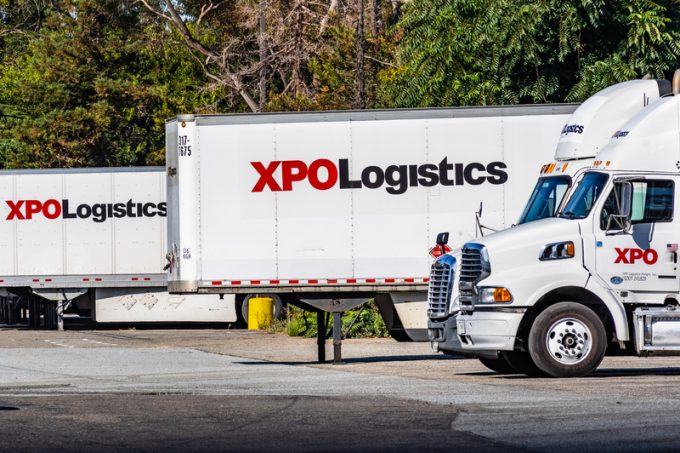Whopping $50bn FedEx Freight? Or?
Running the numbers
TFII: SOLID AS USUALMAERSK: WEAKENINGF: FALLING OFF A CLIFFAAPL: 'BOTTLENECK IN MAINLAND CHINA'AAPL: CHINA TRENDSDHL: GROWTH CAPEXR: ANOTHER SOLID DELIVERYMFT: HERE COMES THE FALLDSV: LOOK AT SCHENKER PERFORMANCEUPS: A WAVE OF DOWNGRADES DSV: BARGAIN BINKNX: EARNINGS OUTODFL: RISING AND FALLING AND THEN RISING
TFII: SOLID AS USUALMAERSK: WEAKENINGF: FALLING OFF A CLIFFAAPL: 'BOTTLENECK IN MAINLAND CHINA'AAPL: CHINA TRENDSDHL: GROWTH CAPEXR: ANOTHER SOLID DELIVERYMFT: HERE COMES THE FALLDSV: LOOK AT SCHENKER PERFORMANCEUPS: A WAVE OF DOWNGRADES DSV: BARGAIN BINKNX: EARNINGS OUTODFL: RISING AND FALLING AND THEN RISING

Another battlefront has opened between XPO Logistics and driver labour unions.
The Teamsters union has filed a request with the National Labor Relations Board for a unionisation election by some 250 drayage drivers who work for XPO on a gig basis serving ports and rail yards in the Los Angeles/Long Beach area.
Although classified as contractors, the drivers claim they are operating like employees – but without benefits like healthcare, paid sick leave and overtime pay.
The Teamsters accompanied the unionisation election request with a formal complaint, accusing XPO of violating labour legislation by misclassifying the drivers as contractors.
According to a lawyer for the truckers, the company deducts payments for truck leases, fuel, parking, tables and administration from contractor compensation, in some cases resulting in ‘negative pay cheques’ after a week of work.
The Teamsters’ move is the latest skirmish in its confrontation with XPO. In October, the company settled a class action filed in 2018 over classification of drayage drivers and payments below minimum wage levels. The plaintiffs had argued that the firm ought to compensate contractors for elements like wait-time penalties, paperwork and other business expenses, or for missed meal and rest periods. XPO agreed to pay $30m without accepting the misclassification charge.
In response to the latest development, a spokesman said XPO respected the right of every employee to choose or decline union membership.
The company has some 12,000 drivers classified as employees, and only a few hundred trucking contractors, who are “welcome to apply for any number of truck driver openings offered by XPO”, although these would be less likely in the drayage segment.
XPO has argued that many independent business owners contracting with it prefer the contractor model because of the flexibility it gives them.
According to the California Trucking Association (CTA), more than 70,000 owner-operators in California “choose to work independently because of the freedom, flexibility and business growth potential that business model provides”.
The CTA has been at the forefront of industry opposition to California’s controversial AB5 law, which aims to make it easier for independent contractors to become re-classified as employees. The bill was passed in September 2019 and supposed to become effective in January 2020, but has been mired in legal wrangling.
Last summer, the CTA asked the US Supreme Court to review AB5, arguing that motor carriers should be exempt from enforcement as state law is pre-empted by federal legislation.
But last year, the California state legislature passed three additional pieces of legislation. One identifies trucking firms in violation of labour, employment and health and safety laws, and notifies their clients that they could be held financially accountable. Another ties grants for clean truck efforts to workforce compliance standards, while the third gives misclassified drivers critical employment insurance benefits and holds trucking firms responsible for payroll taxes.
There is a feeling among US logistics executives that red tape is hampering their ability to do business. One claiming it undermined competitiveness with other countries.
Another singled out the west coast for its abundance of red tape that made it “next to impossible for smaller companies to exist”. He wants a “healthy balance” between the restrictive regime there and the legislative environment in Texas, currently “polar opposites”.
Nationwide the number of drayage operators increased markedly last year. Platform Drayage.com added 1,228 new drayage carrier listings, while the Intermodal Driver Database of the Intermodal Association of North America registered 1,630 new drayage firms, mostly single-truck operators.
This suggests drayage drivers have left employment to strike out on their own. The surge in drayage operator numbers has been attributed to a hefty rise in spot rates, which were more than twice the level of contract rates last autumn.
Most of the new operators have sprung up in south-east US. California would seem to be more challenging for drayage truckers to operate on their own, given the congestion at ports which has slowed down trucker operations. Wait times at container terminals, combined with the problems with chassis availability and difficulties turning in empty boxes, have eroded efficiency.
Instead of six or seven jobs a day, drayage drivers now average about three, according to one source. On top of this, truckers face possible fines for missing appointments while stuck at terminals.
Comment on this article